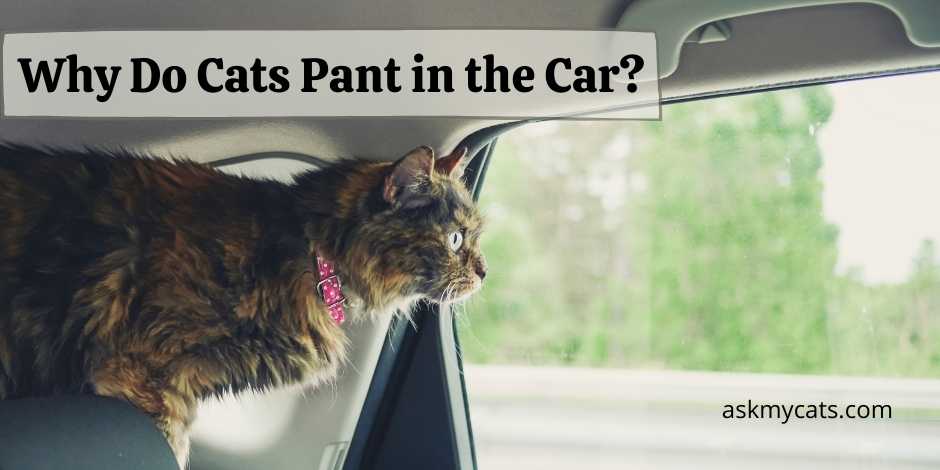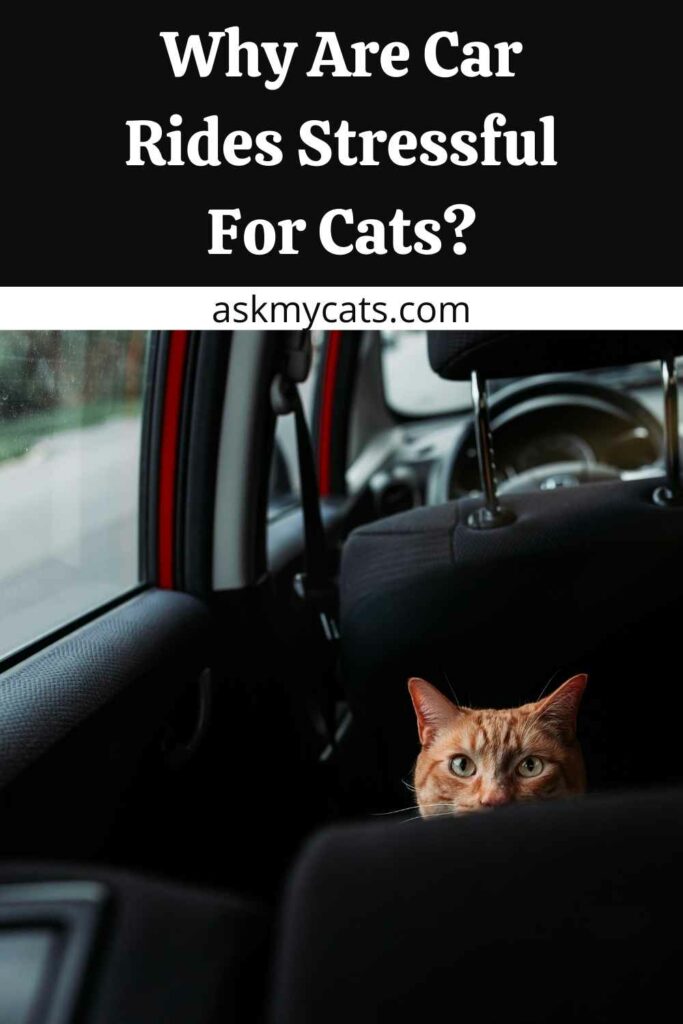Cats, unlike dogs, do not appreciate vehicle journeys. On the contrary, they despise automobile journeys and become agitated if forced to undergo one. They may demonstrate this by meowing loudly, pacing, or drooling.
Cats dislike traveling by car and, in most cases, become disturbed and even violent while doing so. If they are nervous or anxious, they may also pant in the car.
While panting is typical in dogs, it is not normal in cats and might be the reason for concern.


Give Your Cat the Perfect Day
Get the Free Ebook!
Cats Panting In Car
Since cats do not sweat, they will pant in the car when their heart rate rises.
Because of the abrupt shift in surroundings, cats often become nervous and worried during automobile excursions. They dislike change and find other areas they have never been to be unsettling. The good news is that any panting brought on by a car journey should stop as the cat relaxes.
A cat’s overheating and panting might also be caused by the hot temperature inside the automobile.
Cats usually have no trouble controlling their body temperature by seeking out cool locations in your house. It will be tough for them to chill off if they are locked in their carrier in the automobile.
Cats Crying In Car
Cats will cry in the car when they do not like the journey.
Cats and car journeys are, unfortunately, unavoidable. While cats aren’t required to go to work every day, they should visit the veterinarian at least once a year.
Anyone who has ever shared a car with a meowing, stressed-out kitty understands how miserable the journey can be for all parties involved.
You might also like to read about do cats pant when stressed
Understanding the underlying issue is crucial to finding a solution. Most cats’ only time in a car is when they are placed in a carrier and transported to the veterinarian when checked from head to tail by an unfamiliar person, have their temperature taken rectally, and maybe even receive injections!
Getting into a car doesn’t always imply a trip to Disneyland to view the world’s largest rodent. Nope! The automobile conjures up just one image for most cats: a trip to the vet to be probed and prodded.
Before letting your cat out, make sure he’s wearing current identity tags. All animals, especially indoor-only cats, should have microchips and ID tags. I’ve seen far too many lost cats and heard far too many tales about cats being lost when visiting the vet.
When they understand they’re heading to the veterinarian, some cats will try to bolt out the door. If the carrier door is not adequately secured, others will flee. Make sure your cat is wearing a collar, ID tags, and, ideally, a microchip before you leave.
Maintain a carrier for all traveling cats. This is for both your and your cat’s protection. It’s not a good idea to drive with your cat wandering about freely in the car.
Your cat may become startled and dart under the brake or accelerator pedal, perhaps causing an accident.
Having a cat leap about the vehicle is also a harmful distraction. To be safe, put your cat in a secure carrier at all times.
Imagine being jolted awake from an afternoon nap by someone snatching you and squeezing you into an unknown box while struggling and screaming. That’s probably how our cats feel when we put them in a carrier to take them to the veterinarian.
Understandably, cats despise being placed in a carrier. Rather than creeping up on them and forcing them into the carrier, we should work to make it a more pleasant experience for them. Allow your cat to grow acquainted with the carrier by bringing it out a few days ahead of time.
Allow him to explore the container at his leisure by leaving the door open. Spray a synthetic feline pheromone substance onto the interior of your cat carrier. These items have been proved to help cats cope with stress.
You may also fill the carrier with your cat’s favorite goodies or catnip to help your cat connect the carrier with a pleasurable experience. If your cat is fasting for anesthesia or particular blood tests, avoid treats.
Place a nice blanket from home and your cat’s favorite toys inside the carrier to make it more pleasant. Placing everyday items inside the carrier will make it feel less weird and more welcome.
Must Read: Can A Cat Ride In A Car Without A Carrier?
Why Does My Cat Hyperventilate In The Car?
Cats hyperventilate in cars because they don’t feel comfortable breathing.

Since it is a unique environment, it pushes individuals out of their comfort zone and frequently influences a negative incident.
We don’t assist our felines in developing positive associations with automobiles as we do with dogs. Still, you can make a car journey less stressful for everyone, even the driver, with a little effort!
On the other hand, cats appear to have a greater memory than dogs. They’re able to link the carrier to a specific memory of what transpired. This implies that cats recall going to the clinic or having their claws cut for the most part.
Even if there isn’t a person present to open a can, cats survive. They retain their ‘wild’ nature because they were not developed specifically like dogs.
Given that cats are both solitary and territorial, it’s understandable that automobile journeys might be a stressful experience for them.
You might also like to read about why my cat panting after playing
Why Are Car Rides Stressful For Cats?
Cats pant in cars because they are anxious and have a high heart rate.

Cats are jittery travelers that despise being in a car. They are territorial and dislike being confined to a carrier, seated in an unfamiliar seat, and transported to a new location outside of their area.
Cats get sickness while traveling long distances by automobile, so they pants. Cats’ inner ears are sensitive, and they become dizzy, queasy, and bewildered due to the vibrations and sounds of a running car.
When cats are agitated, they prefer colder temperatures. It may benefit your cat if you keep your car cool (not frigid) and use the air conditioner.
Cats, as previously said, dislike changes in their surroundings and are fearful of disruptions in their daily routine. Cats might become fearful after long automobile journeys.
Moving your cat from its comfortable region into a new moving environment (a car) might be frightening for him. If your cat is panting for no apparent reason other than fear or heat, it might be a sign of something more severe.
Make an appointment with your veterinarian right away if this happens. Heavy breathing might indicate that your cat is suffering from oxygen shortage due to a cardiac arrhythmia brought on by stress.
Other medical issues can also cause panting. Take your cat to the veterinarian if he pants when he gets upset.
How Can I Tell If My Cat Is Stressed In My Car?
You can see the cat breathing heavily and panting when stressed in the car.
If your cat has never been in a car or hasn’t been in one in a long time, you should do a test drive first. Take your kitten for a short journey in a stylish cat carrier that latches into the car.
Find out what makes her jittery. Is it true that music makes her angry, yet a podcast makes her feel better? Is it simply a matter of lowering the volume?
To minimize all the sights and sounds to a minimum, your cat might prefer a lightweight blanket to her carrier. Alternatively, she may require someone to sit next to her in the backseat and offer calming words to her.
Motion sickness may be present if your cat drools, cries a lot, pants, or spits up throughout the journey. You might wish to speak with your veterinarian about possible treatments.
Interesting Read: Cat Pee In Car: How To Get Rid Of Cat Pee Smell In Car?
How Can I Calm My Cat Down In The Car?
It would be best to make your cat comfortable in the car by playing and spending time with him.

Some cats like traveling, especially if they have been doing it since they were kittens. However, some cats require a little additional assistance to remain quiet.
Maintaining a sense of regularity for your kitten is critical when traveling. This sense of normalcy will help your cat relax.
Bring all of your cat’s essentials with you, including food, bowls, toys, travel-sized litter, and a bed or blanket.
Pick your cat’s favorite or one she spends a lot of time in when deciding which bed or blanket to bring. The familiar feel and fragrances will provide a sense of security.
Put your cat’s carrier in your house for a few days before the trip to increase the sense of routine and relax your cat. Keep a favorite blanket or towel inside.
Give her goodies in the carrier on occasion as well. When you place the carrier in the car, the idea is to smell like home and for your cat to find it soothing by the time you get on the road.
Play with your cat a lot before you go on your trip to make him feel more at ease. A wand chase or a red laser pointer chase with plenty of hopping and running will make him feel prepared to cuddle down for the long drive.
Some cats will feel more at ease on the road if they have a companion. When your cat becomes agitated, speak softly to him. If you have a passenger in the seat next to your cat, she can lay a calming touch on the carrier and talk soothingly.
Alternatively, you can secure your cat’s carrier in the seat next to yours.
You don’t want a startled cat springing out and hiding behind the brakes at your feet if you open the container while driving. Keep the music quiet and speak gently and steadily. If possible, take twists and bumps carefully so you don’t startle your cat.
Interesting Read: Can You Travel With A Pregnant Cat? Is It Safe?
Frequently Asked Questions
Is the cat panting badly?
Panting is natural if your cat has been playing or racing about. Allow your kitten or cat to relax for a while, and their breathing should return to normal. Take them to a cooler spot and give them plenty of water if they are overheated outside or in a hot environment.
Why would a cat pant heavily?
Cats pant when they are hot, nervous, or anxious, or after vigorous exercise, just like dogs. When the cat has had a chance to calm down, cool down, or rest, this panting should stop. However, this type of panting is considerably less common in cats than in dogs.
Is traveling stressful for cats?
Any travel, whether by airline, train, or vehicle, can agitate your cat and induce stress behaviors. Unfamiliar, enclosed situations can upset your otherwise well-behaved pet, and spending time in them could exacerbate the problem.
Final Words
Cats may have trouble adjusting to being in a car. If this is your circumstances, you may want to consider leaving your cat at home or at a pet hotel. If you opt to leave your cat at home alone, have someone come by regularly to check on her and leave a list of instructions.
Drop your questions in the comments section below.
